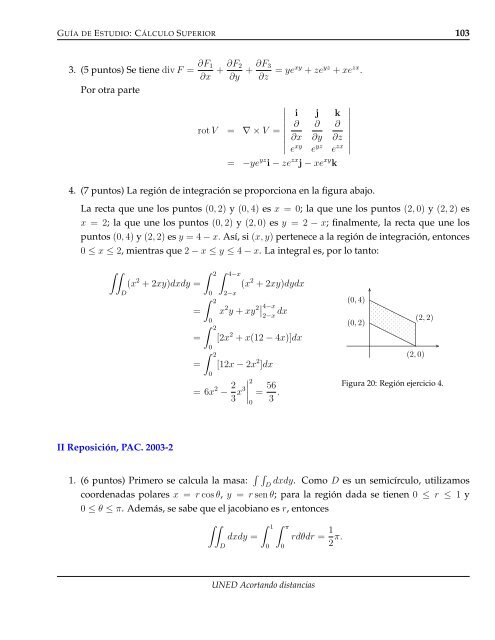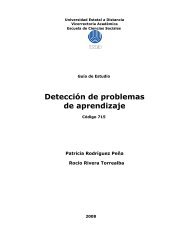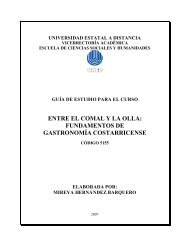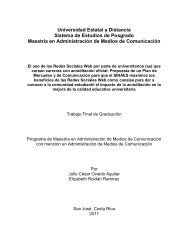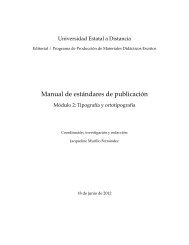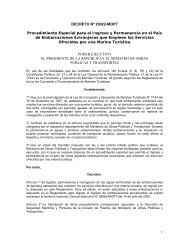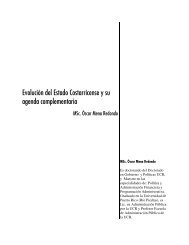GE3011 Cálculo Superior - Repositorio de la Universidad Estatal a ...
GE3011 Cálculo Superior - Repositorio de la Universidad Estatal a ...
GE3011 Cálculo Superior - Repositorio de la Universidad Estatal a ...
Create successful ePaper yourself
Turn your PDF publications into a flip-book with our unique Google optimized e-Paper software.
GUÍA DE ESTUDIO: CÁLCULO SUPERIOR 103<br />
3. (5 puntos) Se tiene div F = ∂F1<br />
∂x<br />
Por otra parte<br />
+ ∂F2<br />
∂y<br />
+ ∂F3<br />
∂z = yexy + ze yz + xe zx .<br />
<br />
<br />
<br />
i j k <br />
<br />
<br />
rot V = ∇ × V = <br />
∂ ∂ ∂ <br />
<br />
<br />
∂x ∂y ∂z <br />
<br />
<br />
<br />
e xy e yz e zx<br />
= −ye yz i − ze zx j − xe xy k<br />
4. (7 puntos) La región <strong>de</strong> integración se proporciona en <strong>la</strong> figura abajo.<br />
La recta que une los puntos (0, 2) y (0, 4) es x = 0; <strong>la</strong> que une los puntos (2, 0) y (2, 2) es<br />
x = 2; <strong>la</strong> que une los puntos (0, 2) y (2, 0) es y = 2 − x; finalmente, <strong>la</strong> recta que une los<br />
puntos (0, 4) y (2, 2) es y = 4 − x. Así, si (x, y) pertenece a <strong>la</strong> región <strong>de</strong> integración, entonces<br />
0 ≤ x ≤ 2, mientras que 2 − x ≤ y ≤ 4 − x. La integral es, por lo tanto:<br />
<br />
D<br />
(x 2 + 2xy)dxdy =<br />
II Reposición, PAC. 2003-2<br />
=<br />
=<br />
2 4−x<br />
0<br />
2<br />
0<br />
2<br />
0<br />
2<br />
2−x<br />
(x 2 + 2xy)dydx<br />
x 2 y + xy 2 4−x<br />
2−x dx<br />
[2x 2 + x(12 − 4x)]dx<br />
= [12x − 2x<br />
0<br />
2 ]dx<br />
= 6x 2 − 2<br />
3 x3<br />
2<br />
<br />
<br />
= 56<br />
3 .<br />
1. (6 puntos) Primero se calcu<strong>la</strong> <strong>la</strong> masa:<br />
0<br />
<br />
D<br />
(0, 4)<br />
(0, 2)<br />
. .<br />
. .<br />
. .<br />
.<br />
.<br />
.<br />
.<br />
.<br />
.<br />
.<br />
.<br />
. . . . . .<br />
.<br />
.<br />
.<br />
.<br />
.<br />
.<br />
.<br />
.<br />
.<br />
.<br />
.<br />
.<br />
. .<br />
. . . . . . . .<br />
.<br />
.<br />
.<br />
.<br />
.<br />
.<br />
.<br />
.<br />
.<br />
.<br />
.<br />
.<br />
.<br />
.<br />
. . .<br />
. . .<br />
. . . . . . . . .<br />
.<br />
.<br />
.<br />
.<br />
.<br />
.<br />
.<br />
.<br />
.<br />
.<br />
.<br />
.<br />
. .<br />
.<br />
.<br />
.<br />
.<br />
. . .<br />
. . . . .<br />
. .<br />
.<br />
.<br />
.<br />
. .<br />
.<br />
.<br />
.<br />
.<br />
.<br />
. . . .<br />
. .<br />
.<br />
.<br />
.<br />
.<br />
.<br />
.<br />
.<br />
. . .<br />
.<br />
.<br />
.<br />
.<br />
(2, 2)<br />
(2, 0)<br />
Figura 20: Región ejercicio 4.<br />
dxdy. Como D es un semicírculo, utilizamos<br />
coor<strong>de</strong>nadas po<strong>la</strong>res x = r cos θ, y = r sen θ; para <strong>la</strong> región dada se tienen 0 ≤ r ≤ 1 y<br />
0 ≤ θ ≤ π. A<strong>de</strong>más, se sabe que el jacobiano es r, entonces<br />
<br />
D<br />
dxdy =<br />
1<br />
0<br />
π<br />
UNED Acortando distancias<br />
0<br />
rdθdr = 1<br />
2 π.<br />
..


